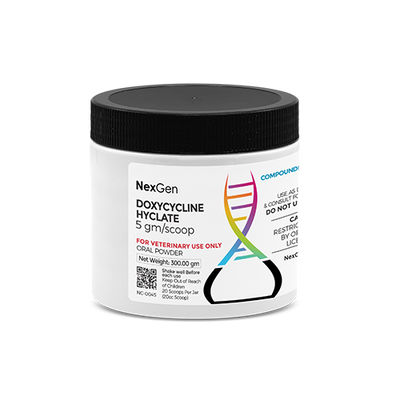
Doxycycline Hyclate 5 gm/scoop, Oral Powder, 30 Scoops (20cc Scoop)
Login for pricing
- Brand
- Mixlab
- SKU:
- NC-0219
- Product Type:
- Powder
- Size:
- 32oz
- Administration:
- Oral
- Scoops Per Container:
- 30
- Scoop Size:
- 20cc
Bacterial infections present a major challenge in equine medicine.1 There are literally dozens of commonly-occurring pathogenic bacteria that can infect horses, with the potential to affect any system in the body. Horses are exposed to bacteria daily; in most cases, a horse’s immune system is able to fight off bacterial intrusions without developing clinical signs of sickness. Bacterial disease occurs when a horse’s immune system is weakened and the bacteria is able to replicate and spread in the horse’s body.
The source of bacteria can be contaminated water, food or feces; however, in the case of some bacterial infections (e.g., skin, respiratory), the causative agent may be present in the environment. Like humans and other animals, horses often develop bacterial disease after their immune system has already been compromised by a virus. Bacterial infections are more common in horses that that travel or spend a lot of time at training stables where lots of different horses are coming and going. Foals and geriatric horses are much more at risk of becoming sick because their immune systems are not as strong as adult horses in their prime.1
Common Bacterial Diseases of the Horse
Since the types of disease and bacterial agents vary widely, a horse owner or manager may suddenly encounter any number of divergent symptoms, from diarrhea to coughing to an abscessed leg. Bacterial infections generally do cause a fever and lethargy. Therefore, cleanliness around the stable or barn are key to keeping bacteria from spreading. It is generally a good idea for each horse to have its own supplies and grooming tools to prevent spreading germs in stables where many horses congregate.
Some of the more common bacterial diseases in horses include:
Brucellosis(Brucella spp.) is a bacterial disease caused by contact with infected animals and contaminated animal products like raw milk. In horses, brucellosis can cause lameness due to joint infection, including fistulous withers. It also causes abortions in pregnant mares, although this is uncommon.
Cryptosporidiosis(Cryptosporidium spp.) is a parasitic disease which is usually spread via the ingestion of infected feces. Horses infected with cryptosporidium often do not evidence signs of illness, although pre-weaned foals appear to be more likely to experience diarrhea than weanlings and yearlings, and older horses.
Leptospirosis(Leptospira spp.) is a bacterial disease that can affect humans as well as animals. Many animals can carry the bacteria in their urine, including horses. The bacteria that cause leptospirosis spread through the urine of infected animals, which can get into water or soil and survive there for weeks to months.2 In horses, leptospirosis is most often associated with eye problems, such as cloudiness or the eye or uveitis (inflammation in the eye). It can also cause other symptoms such as fever, stillbirths and abortions, and kidney failure.
Salmonellosis(Salmonella spp.) is most commonly spread through contaminated food. Salmonella can also be contracted from animals, including horses. Salmonella most often spread to animals and people through the feces of infected animals, contaminated food, or the environment. Horses infected with Salmonella may show no signs of illness, or they may experience diarrhea, dehydration, or depression.
Anthrax(Bacillus anthracis) is an extremely serious disease of caused by bacteria found in the environment, although it is rare in the United States. Horses can become infected with anthrax when they ingest spores in contaminated soil, plants, or water. Signs of anthrax in the horse may include fever, chills, severe colic, anorexia, depression, weakness, bloody diarrhea, and swellings. Anthrax is usually fatal in horses.
Tick-borne diseases present a significant risk to horses. Among these are Lyme disease, tularemia, and anaplasmosis. Ticks become exposed after biting an infected animal; the bacteria are then spread through the bite of an infected tick. Horses infected with a tick-borne disease may or may not show signs of disease. Signs and symptoms range from mild illness to death.2
Oral Doxycycline for Horses
Doxycycline is broad-spectrum antibiotic composed of a semi-synthetic tetracycline derived from oxytetracycline. It is commonly used to treat dogs, cats and horses. In horses, it is often used for treating bacterial infections, including Potomac Horse Fever, other Ehrlichia infections, and Lyme disease.
Although there are currently no FDA-approved veterinary doxycycline products available, the drug’s favorable pharmacokinetic parameters as compared with either tetracycline or oxytetracycline make it a preferable choice to use in animals when a tetracycline is indicated, particularly in azotemic patients.3
Dosages for doxycycline in horses are as follows (adapted from Plumb’s Veterinary Drugs):
NOTE: Commercially available PO doxycycline hyclate or monohydrate has low bioavailability in horses, and treating Lyme disease or anaplasmosis may be problematic.
-
Borrelia burgdorferi infection (causative agent of Lyme disease) (extra-label): 10 mg/kg PO every 12 hours. Treatment for 2 weeks may be adequate for early stage infections, whereas treatment for 1 to 2 months may be required for neuroborreliosis or patients with ocular involvement.
-
Equine granulocytic ehrlichiosis (anaplasmosis; EGE) as an alternative to oxytetracycline (extra-label): 10 mg/kg PO every 12 hours for 10 to 14 days.
-
Organisms with an MIC less than or equal to 0.25 μg/mL, including many susceptible Streptococcus spp, Staphylococcus spp, Pasteurella spp, Rhodococcus equi, Actinobacillus equuli, and most Ehrlichia spp organisms (extra-label): 20 mg/kg PO once daily (every 24 hours); food should preferably be withheld for at least 8 hours before and 2 hours after administration.
-
For bacteria with an MIC of 0.5 –1 μg/mL, 20 mg/kg PO every 12 hours is necessary to maintain adequate trough levels. Feeding should ideally be withheld as above, but this may not be practically possible.
WARNING: IV administration of doxycycline in horses has been associated with fatalities.3
Where to buy Doxycycline
Doxycycline is available in the U.S. through several pharmaceutical manufacturers and through veterinary custom compounding companies. DOXYCYCLINE 5 GM/SCOOP (30 SCOOP) by NexGen Pharmaceuticals has similar activity to other forms of tetracyclines against susceptible organisms, but some strains of bacteria may be more susceptible to doxycycline.
Please consult your veterinarian prior to beginning any treatment regimen.
FOR RX ONLY: A valid prescription from a licensed veterinarian is required for dispensing this medication.
1Panchaud Y, Gerber V, Rossano A, Perreten V. Bacterial infections in horses: a retrospective study at the University Equine Clinic of Bern. Schweiz Arch Tierheilkd. 2010 Apr;152(4):176-82. doi: 10.1024/0036-7281/a000040. PMID: 20361396.
2cdc.gov.
3Plumb’s Veterinary Drugs.














